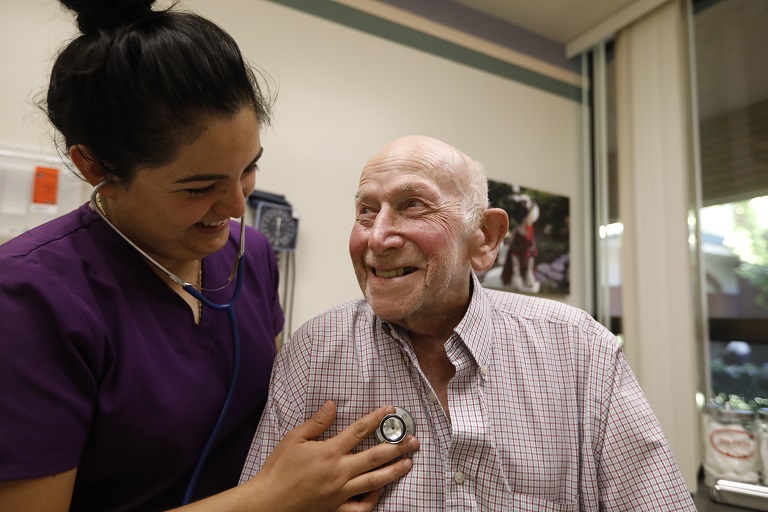Trends Report Review: Senior Housing Trends 2021
Love & Company’s 2021 Senior Housing Trends review explores seven key areas of focus that will have a significant impact on the future of aging services, and Life Plan Communities specifically. Within each area, a collection of thought-leaders have lent their insight to the conversation, and share penetrating observations, tools, and trend forecasts that operators can use for strategic planning and development.
The booklet begins with a broad overview of market demographics by Karen Adams and Lauren Houlik of Love & Company. The growing size of the aging population is reviewed, as well as are income and net worth, household type and education statistics for those aged 65 and above. Between now and 2029, the population aged 75 years and above will increase at the fastest rate within the last thirty years. A promising trend, under income and net worth, is that there are more households with a net worth of more than $1 million in the 65-74 age range, suggesting that there will be a future market for entrance-fee LPCs; also, there will be more than twice the number of households with assets in the “middle market” range, where there is abundant opportunity for development. Interestingly, the 2029 projections of household type suggest that most households will retain a consistent percentage of single-person households; the volume of both single-person and two-person households will dramatically increase. The highest-attained level of education will increase over time, with more people over the age of 65 holding a bachelor’s degree or higher.
· Health and Wellness
Tom Mann of Moorings Park Communities wrote about the “Search for the Fountain of Youth.” Mr. Mann’s advocation is the need to fully integrate a comprehensive health and wellness program into community living, with a keen focus on “the details” and the execution of the program. He offered a list of important questions, from the perspective of the resident, to probe leaders’ thinking on how to create and sustain a world-class wellness program. One such question is, “Do you have a team that is preparing my personalized health and wellness plan? If so, who is on that team?”
John Franklin of Pearl Creek Advisors wrote about “Embracing a New Value Proposition” in wellness programming. He talks about shifting from a “care model” to a “vitality model” that focuses on what helps people thrive in their community. Three short videos on embracing social connection as a value proposition are referenced, and then Mr. Franklin offers a series of tips on how to address this new value proposition with your board. One such tip is, “Introduce healthcare navigation as a key service and alternative to moving through the traditional healthcare continuum.”
Kyle Robinson of WellZesta wrote about “The Value of Social Engagement in Communities.” She highlighted the irony of the social isolation crisis that happened in retirement communities during the pandemic – communities that pride themselves on social connection and programming. A saving grace has become technology as a means to connect virtually, and she gave quotes from a small study of older adults who observed the benefits of using technology to socialize. To quote her directly, Ms. Robinson insightfully observed that “to increase social engagement’s value, we must become digitally intimate with those experiencing our technology.”
· Strategic Planning and Finance
Toby Shea of OnePoint Partners talked about the “Increased Demand for Rental Senior Living and the Implications on Your Entrance Fee Organization.” He referenced a 28% increase in renters older than age 55, and identifies two reasons why older adults may choose a rental living arrangement: affordability and freedom. Seeking to keep their limited assets liquid, Mr. Shea predicted that most baby boomers will prefer the financial flexibility of a rental community, and the freedom of not being tied into a long term commitment for a property that still offers many of the lifestyle benefits of an entrance fee LPC. He then outlined two approaches for pursing a rental project as a provider, and lists several recommendations for success, including, “have a sound understanding of the potential financial implications of adding rental—particularly if it is replacing entry fee product—and the impact on cash flow moving forward.”
A.V. Powell and Molly Shaw of A.V. Powell and Associates wrote about “The Future of Continuing Care Contracts.” After a fascinating look at the history and evolution of the LPC contract model, Mr. Powell and Ms. Shaw explored how the different contract types appeal to consumers of respectively varying risk tolerance profiles; Type A contracts are most appealing to the risk-adverse, and type B or C to the most risk-tolerant. The overall conclusion is that successful providers will offer an array of contract types to their prospective residents, and that some of those contracts should offer the ability for the resident to receive some supports and services in their independent living home.
Brad Paulis and Chris Borcik of Continuing Care Actuaries wrote about “Strategic Planning for Higher Levels of Care.” Mr. Paulis and Borcik considered the accelerating pressure on LPCs to downsize their skilled nursing care, a trend that is driven by consumer demand. Many consumers now and in the future have a strong preference to age in place. The authors posed three key questions to consider regarding home care, assisted living, and dementia care, and then offer several points to consider when engaging in strategic planning with your board of directors. One such point is, “Determine efficient unit operations by examining a range of options and weighing the pros and cons of each.”
Lisa McCracken of Ziegler wrote about “Joint Ventures and Partnerships.” Ms. McCracken started off with the statistic that 34% of LZ200 providers are in a formal joint partnership, and she listed multiple examples. She then expounded on a series of reasons ‘why to enter into a joint venture,’ including “the ability to diversify into alternative business lines with pooled resources from partners (human resources, capital) allows for growth that may not otherwise be possible alone.”
Stephen Johnson of Ziegler wrote about “The Momentum Behind Not-for-Profit Sponsorship Transitions.” He walked through the seven most common reasons why not for profits seek consolidation, and offered sample ‘red flags’ from a checklist Ziegler has created to help boards walk through the consideration of a sponsorship transition. One such red flag that signaled readiness for a sponsorship transition was, “There are concerns about the ability to fulfill payment of debt obligations.”
Melissa Andrews of LeadingAge Virginia wrote about “The Middle Market Playbook.” Ms. Andrews reviewed the demographics of the middle market, and made the case for why LPCs should consider diversifying into this market. She listed out a series of questions to help organizations get started on their strategic planning, including mission, operational and partnership questions. One such example is, “does serving a middle-market customer fit within our core competencies?”
Melissa Messina of HJ Sims wrote about “Innovative Financial Strategies to Create Operational Cash Flows.” Ms. Messina outlined the issues around accessing tax-exempt bond financing in the municipal bond market, and then gave several examples of alternative strategies organizations can use to access needed capital from the bond markets. These include Cinderella bonds, taxable fixed rate advanced refunding, forward refunding and a tender offer. She closed by observed that these alternative strategies may no longer be viable routes to borrowed capital, depending on how legislative changes affect the 2017 Tax Cuts and Jobs Act.
· Design and Technology
J. David Hoglund of Perkins Eastman wrote about “Design Alternatives to Evolve Beyond Pandemic Influences.” Mr. Hoglund began by exploring the question, “Why would seniors want to move into group living right now?” Because the data seems to indicate that older adults are still just as interested in moving in to retirement communities, post-COVID 19, he then outlined the structural evolutions and new dining norms that communities should prepare to embrace, such as air flow and ventilation, safe family visit areas, smaller dining areas and technology-enabled dining services.
Mike Kivov of OnePoint Partners wrote about “The Changing Face of Long Term Care.” Saying that, since COVID, we are in a ‘transformative period” in long term care that will be driven by “lasting changes in consumer behavior,” Mr. Kivov outlined notable trends in skilled nursing, assisted living and dementia care. Right-sizing skilled nursing areas, providing more assisted living services in the home, and the continued need for residential dementia care were core discussion points.
Michael J. Martin of RLPS Architects wrote about “Next Generation Amenities for the Next Generation Consumer.” To attract the transient tastes of the incoming Baby Boomer generation, Mr. Martin reviewed a variety of new amenities and services communities are offering. These include rooftop terraces with firepits; digital technology in dining rooms to transform the “look” from afternoon to evening meal service, bowling alleys and arcades for family fun; and wellness centers with state of the art equipment and programming.
Karen Adams of Love & Company wrote about “Evolving Our Communities to Prepare for Increased Consumer Use of Technology.” Because the incoming consumer will have an expectation of technology-enabled services and entertainment, Ms. Adams reviewed several emerging trends that providers should be aware of. These included telemedicine, on-demand services, and issues older adults face in the utilization of technology. Better design of technology platforms to meet the needs of older adults, and offering tech support services to implement those platforms were highlighted as key needs.
Keith Stewart of K4Connect wrote about “Smart Home and Senior Living Trends.” Mr. Stewart discussed how the utilization of smart home technologies is on the rise, along with consumer demand for these technologies. He outlined four trends to watch in this area: 1) everything will be connected, and orchestration will be essential; 2) proliferation of internet of things devices will continue to grow, and integration capabilities will grow along with it; 3) smart home technology will be core to risk mitigation and extending staff coverage; 4) the data and macro trend analysis will be huge.
Karen Adams of Love & Company also wrote about, “Are Autonomous Vehicles in Your Community’s Future?” Ms. Adams reviewed the evolution of autonomous vehicles within the last few years, and gave examples of places, such as The Villages in Florida, where such vehicles are already being used. Whether or not older adults would be willing to give up care ownership for the use of such vehicles, and how to partner with service providers such as Lyft and Uber were also discussed.
· Beyond our Walls
Nancy King of Senior Options wrote about how to “Generate Additional Revenue through Home Care and Home Health.” Ms. King discussed the strong opportunities that exist in venturing into home and community based services, and then she outlined six best practices for doing so. These included: 1) what is your why?; 2) know your market; 3) focus on operations; 4) invest in your IT infrastructure; 5) start with the highest margin service lines; 6) manage quality of care.
Kevin McLeod of Carolina Meadows and Ben Unkle of Westminster-Canterbury of Chesapeake Bay wrote jointly about how to “Advance Your Mission Using an Early Advantage Program.” Also known as Early Admission or Early Acceptance Programs, the authors stated that these are more easily established than HCBS programs, and function in a similar way to an LPC contract. The programs at both organizations were described in detail, with the conclusion that this programs are good ways to draw in additional revenue and establish your market position.
Lisa Hoffman of Pathstones by Phoebe and Amanda Young of Be Well at Home wrote about, “The Future of Continuing Care at Home Programs.” Because many Baby Boomers have more limited resources than the current generation of retirees, and also have a great desire to age in community, the authors argued that now is a prime time for the evolution of continuing care at home programs. The many reasons to establish a CCaH program were discussed, and the authors stated that CCaH is a “compelling alternative to long term care insurance” to the consumer.
· Staffing
Denise Boudreau-Scott of Drive wrote about, “Culture: The Only Way to Fill Your Buildings.” Calling culture an untapped treasure that drives outcomes, the author carefully built a case for why a carefully cultivated community culture is the best business case for a retirement community. She presented data on why now is the best time for culture change, and concluded with the assertion that communities should not be distracted by the symptoms of unhealthy culture, but rather focus on strengthening the culture itself.
Dr. Jacquelyn Kung of Activated Insights wrote about “Using Data Science to Decrease Employee Turnover in Senior Living.” Dr. Kung gave definition to four core areas of staff turnover, and then outlined four key drivers in turnover. These included: 1) job and organization characteristics; 2) individual characteristics; 3) job satisfaction, and 4) external environmental factors. Her closing recommendation was to “get and use data on their workforce and develop sustainable strategies to achieve employee retention results.”
· Diversity, Equity and Inclusion
Rob Love of Love & Company wrote about how to “Make this Year the Year Your Community Begins its DEI Journey.” Mr. Love discussed how DEI is in fact a journey without an “on” switch and that spans the course of many years, requiring deep thought and expert guidance. He gave a few examples of communities that are leading in the DEI space, and then outlined several current societal trends that have emerged as a part of important DEI conversations. He concluded by saying, “I believe that now is the time to foster communication and education, and to build a foundation on which our organizations and communities can be positive thought leaders in our greater communities. It is a time that our country needs healing, and healing can only begin through better understanding.”

Most Recommended
October 15, 2025
 Shutdown Week Three: Impact of Ongoing Closure on Affordable Housing
Shutdown Week Three: Impact of Ongoing Closure on Affordable Housing
December 10, 2025
Fiscal Year (FY) Funding 2026
October 07, 2025
Immigrant Workforce Matching Program Brings Workforce Relief
Recently Added
December 19, 2025
House Moves Forward on Affordable Housing Reforms
December 19, 2025
White House Cannabis EO Paves Way for Research, Access
December 19, 2025
LeadingAge Urges DHS to Maintain "Public Charge" Guardrails
December 18, 2025



